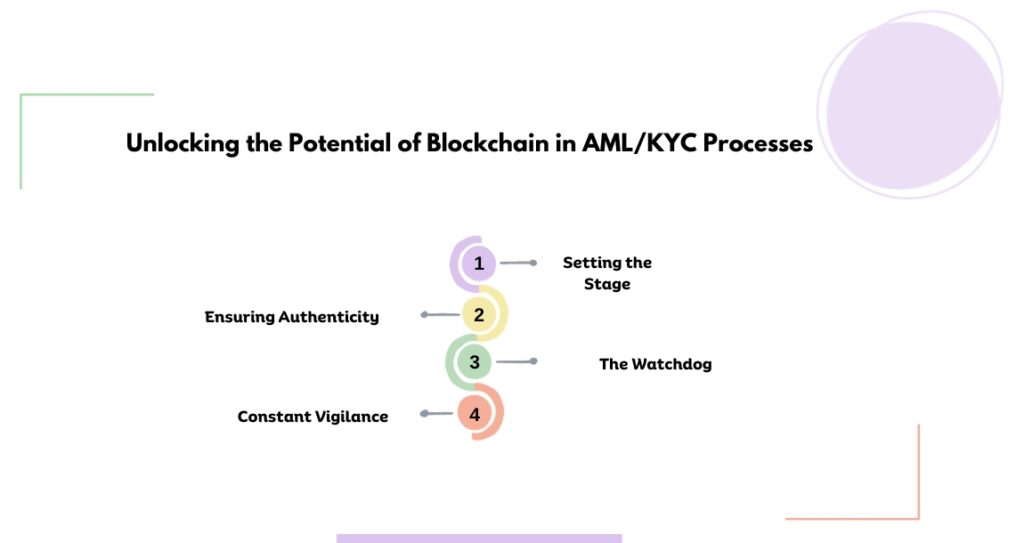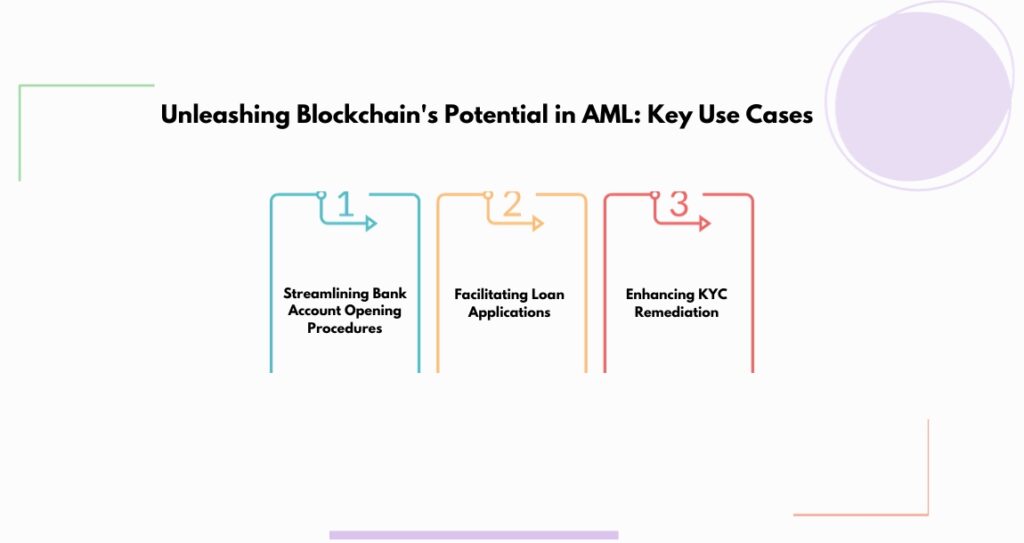Imagine a world where each financial transaction is transparent, secure, and leaves a trail that’s impossible to erase or alter.
Sounds like a dream for financial regulators, doesn’t it? Well, this is where blockchain technology, when incorporated into Anti-Money Laundering (AML) procedures, can work its magic.
This integration of “blockchain in AML” can potentially revolutionize the financial sector, making it more secure and trustworthy. But how exactly does this work? What are the benefits and challenges that come along with it?
Let’s delve into the intricate world of blockchain technology and its pivotal role in preventing illicit financial activities.
Contents
- 1 Navigating the Underworld of Money Laundering
- 2 Unleashing the Power of Blockchain Against Money Laundering
- 3 KYC: The Linchpin in the AML Wheel
- 4 Unlocking the Potential of Blockchain in AML/KYC Processes
- 5 Unleashing Blockchain’s Potential in AML: Key Use Cases
- 6 Does Laundering of Money Occur in Cryptocurrency Transactions?
- 7 Final Words
Navigating the Underworld of Money Laundering
As we marvel at the sweeping benefits of globalization and the leaps and bounds in technology, there’s a flip side to this coin.
Money laundering is one of the darker aspects of our digital era. Cybercriminals are using these advancements to orchestrate sophisticated financial crimes.
Shockingly, the volume of money laundered globally amounts to a staggering $2 trillion per year. To put this into perspective, this sum is comparable to the GDP of Italy – the eighth-largest economy in the world.
The Financial Industry’s Battle Against Money Laundering
Banks and financial institutions are not mere spectators to these illicit activities. Their Know Your Customer (KYC) and Anti-Money Laundering (AML) procedures bolster and maintain a fortune annually, anywhere from $900 million to $1.3 billion.
However, the fiscal implications aren’t the only challenge here.
The Ripple Effects of AML and KYC Compliance
The pursuit of AML and KYC compliance often runs into roadblocks. These processes are frequently inefficient, disjointed, and heavily reliant on manual intervention.
This, unfortunately, can result in sluggish transactions that negatively impact clients’ businesses, leading to strained relationships over time.
Decoding Money Laundering
Money laundering is the crafty process of making illegally earned massive sums of money appear legitimate.
This black-market money often fuels criminal activities, such as the funding of terrorism or drug trafficking. Money launderers employ numerous techniques to clean their dirty money.
Crafty Techniques: Beyond the Cash Register
The most straightforward strategy is to pass off these illegal earnings as revenues from a lawful business, given the amount doesn’t raise eyebrows. However, money launderers often resort to a myriad of other tactics to cover their tracks:
Bulk Cash Smuggling
Sneaking large sums of money across borders to a jurisdiction with less rigid AML regulations.
Black Salaries
Paying employees under the table to evade taxation and maintain anonymity.
Betting on Cricket
Leveraging the massive cricket betting market to disguise their illegal funds as gambling winnings.
Trade-based Laundering
Manipulating invoices and other trade documentation to legitimize illegal proceeds.
Round Tripping
Selling an asset to a foreign entity and buying it back to give the funds a legal facade.
Unleashing the Power of Blockchain Against Money Laundering

Are you curious about the role of blockchain in the fight against money laundering? Well, the unique features of blockchain technology have poised it to be a game-changer in the battle against illicit financial activities.
Tracking Money Trails with Blockchain
Blockchain technology stands out due to its ability to meticulously document every transaction. Each exchange conducted through this medium etches an indelible record.
This feature empowers regulators to easily trace back the origin of funds, making it a challenging task for money launderers to obscure the money trail.
Imagine having a public record-keeper that not only supervises but also authenticates every transaction’s full history.
Blockchain functions in this way, promptly alerting the network users, including those mining cryptocurrencies, about each transaction as it happens.
This system’s strength lies in its ability to flag and halt transactions if any phase, such as the origin or destination wallet, the type or amount of currency, remain unverified.
Blockchain: Your Guard Against Money Laundering
Further enhancing its anti-money laundering (AML) capabilities, blockchain technology enables risk analysis and reporting mechanisms.
Its analytic capabilities span the entire system, offering comprehensive scrutiny instead of limiting it to just the entry and exit points.
Robust Security: Blockchain’s Forte
Imagine a network where each member, or node, holds the power to authenticate modifications. That’s precisely how blockchain operates, rendering it incredibly secure.
Every node possesses a copy of the full ledger, allowing it to cross-check any alterations and spot any unauthorized amendments.
This feature ensures data integrity and immutability, making blockchain an unwavering sentinel against unpermitted alterations.
Fostering Trust Through Transparency
Blockchain’s verifiable and unalterable nature instills a sense of trust among its users. Its transparency and security features lay the foundation for a high level of confidence, which is crucial when moving money or sensitive data across the globe.
Staying One Step Ahead with Smart Contracts
Implementing smart contracts in a blockchain-based AML platform adds another layer of protection. This integration automates fraud detection, making it more efficient and accurate.
Smart contracts come with built-in algorithms that vigilantly monitor every transaction, trigger alerts for suspicious activities, and immediately halt dubious transactions.
Thus, the incorporation of blockchain in AML practices provides overarching supervision of all transactions, making it a formidable tool in the battle against money laundering.
Webisoft is known for designing bespoke smart contracts that cater to your specific needs – be it farming, staking, bridges, vesting, and beyond.
Whether you operate on BSC, Ethereum, Polygon, Solana, or other self-governed blockchain platforms, Webisoft has got you covered.
KYC: The Linchpin in the AML Wheel
Think of KYC, or Know Your Customer, as the Sherlock Holmes in the financial world. It plays a pivotal role in assessing potential risks customers might pose and ensuring compliance with Anti-Money Laundering (AML) laws.
The KYC process involves understanding a customer’s identity, their potential level of risk, and their financial activities. Businesses and financial institutions generally follow a few key steps for KYC:
- Confirming a customer’s identity
- Scrutinizing a customer’s activities
- Evaluating money laundering risks for each customer
Blockchain: The Game Changer in AML and KYC Processes
But what if there’s a way to make these processes smoother and more efficient? Enter blockchain. By leveraging a blockchain-powered AML/KYC platform, data and information pertaining to KYC and AML can be securely logged on a decentralized ledger.
And since data on a blockchain ledger is immutable and transparent to all network members, managing AML/KYC data becomes a seamless task for financial organizations.
Unlocking the Potential of Blockchain in AML/KYC Processes

Are you wondering how a blockchain-based platform can enhance AML (Anti-Money Laundering) and KYC (Know Your Customer) practices? Let’s delve into the step-by-step process.
Setting the Stage: User Profile Creation
Our journey begins with the user filling out a one-time registration on the blockchain-driven AML platform.
During this process, they’ll need to share their personal information, along with identification proofs for KYC purposes.
Ensuring Authenticity: KYC Confirmation
After the user has submitted their details, the relevant financial institution steps in to verify the KYC data. Think of it as a routine check-up but for data, often carried out through various APIs.
Although the user’s data is encrypted and stored on the institution’s server (not on the ledger to keep KYC data off-chain), the process’s integrity isn’t compromised.
Here’s where it gets interesting. Once the bank gives the green light to the KYC data’s accuracy, it’s uploaded on the server, and a unique hash associated with it gets recorded on the Distributed Ledger Technology (DLT) platform.
This hash functions as a seal – if anyone tampers with the KYC data, the seal breaks, the hash changes, and an alert is sent to other institutions on the network.
The Watchdog: AML Analyst
The AML analyst plays a vital role in performing periodic anti-money laundering checks. They monitor the customer’s financial behavior, analyzing aspects like transaction frequency, money flow, tax obligations, and more.
Constant Vigilance: KYC Monitoring
The analyst’s findings contribute to a risk score for each individual, which serves as a gauge of the potential risk they pose. This risk score informs the frequency of KYC monitoring.
For instance, a low-risk user might only need a check-up every three years, while a high-risk individual might need weekly monitoring.
So, what happens when a bank needs to access a customer’s data? The bank simply requests access to the KYC/AML document and the user grants permission.
The bank then cross-references the data with the associated hash functions on the ledger, ensuring data integrity and authenticity.
If a user updates their KYC documents – like obtaining a new passport or license – the system needs to validate these changes.
However, here’s the cool part: the system doesn’t require each financial institution to individually verify the updated records.
Thanks to Smart Contracts, when a user updates their documents, the system automatically reflects these changes.
The institution with the updated records confirms its legitimacy and notifies all other participants via a new hash function.
Unleashing Blockchain’s Potential in AML: Key Use Cases

So, where does blockchain really shine in AML? Let’s explore some practical use cases.
1. Streamlining Bank Account Opening Procedures
Before you can open a bank account, banks must verify your identity and conduct a thorough KYC due diligence to assess any potential risks related to terrorism or money laundering.
Data silos can be eliminated, risk classification can be enhanced, and time-stamped records can be provided by blockchain.
AML/KYC platforms verify the authorized owners of business accounts, requiring personal identification documents.
2. Facilitating Loan Applications
Whenever you apply for a loan, KYC plays a significant role. The financial institution must conduct checks to verify your credit-worthiness and calculate the risks of money laundering and other financial crimes.
With a blockchain ledger, various departments within the institution can quickly access your records, expediting the loan application process.
3. Enhancing KYC Remediation
The beauty of blockchain lies in its capability to store a myriad of information securely. So, for KYC remediation, financial institutions don’t need to ask their existing customers to share their documents again.
All the necessary documents, data, and analyses are stored on the blockchain ledger. Moreover, the KYC remediation process can be automated to extract license expiration dates and send reminders to customers to upload their updated documents.
Does Laundering of Money Occur in Cryptocurrency Transactions?
Ever wondered about the darker aspects of cryptocurrency transactions? Let’s uncover the truth about money laundering in the world of crypto.
The Shady Figures: Cryptocurrency Money Laundering Report
According to a fresh-off-the-press report from a renowned blockchain analysis firm in 2022, the statistics are grim. The criminals managed to launder a staggering $8.6 billion through cryptocurrencies in 2021.
What’s more shocking? This figure indicates a 30% surge compared to the prior year.
Where Does The Illicit Money Go?
The report brings to light an intriguing fact. A surprisingly small number of services receive the majority of cryptocurrency from illicit sources every year.
Intriguingly, it seems many of these services have been established with the express purpose of money laundering.
Comparing Crypto and Fiat Money Laundering
Looking back to 2017, cyber rogues have funneled more than $33 billion in cryptocurrencies, primarily ending up in centralized exchanges.
While these figures are alarming, they are dwarfed when compared to traditional fiat currency laundering.
The United Nations Office on Drugs and Crime offers a startling comparison. It estimates that an astronomical amount ranging from $800 billion to $2 trillion gets laundered each year through fiat currency.
This is up to 5% of the global GDP. In the face of these figures, it’s clear that money laundering isn’t just a problem for the crypto world; it’s a universal concern.
Final Words
Throughout our discussion, we’ve seen how the implementation of blockchain technology can add unprecedented levels of security and transparency to financial transactions.
Blockchain in AML has vast potential, from preventing money laundering in crypto transactions to enhancing AML and KYC procedures.
However, as with any emerging technology, it’s crucial to continually explore, innovate, and refine its applications.
By doing so, we can truly harness the power of blockchain, making the financial world not only more secure but also more efficient. The future of finance could very well be resting on the blocks of a blockchain.
Ready to revolutionize your financial operations with the power of blockchain technology? Webisoft specializes in building custom blockchains and smart contracts that enhance security, efficiency, and trust. Don’t wait.
Take the first step towards a more secure financial future.

